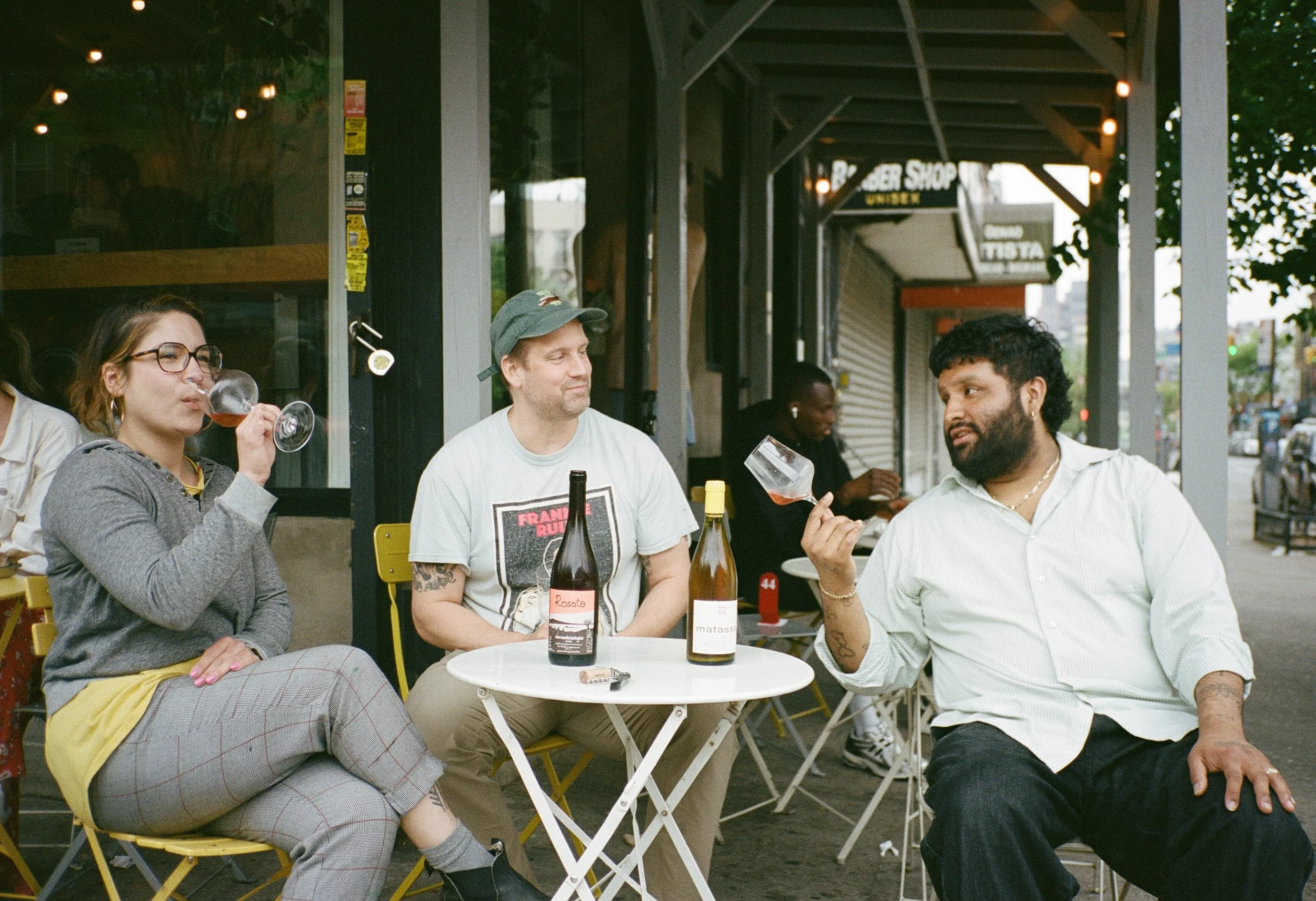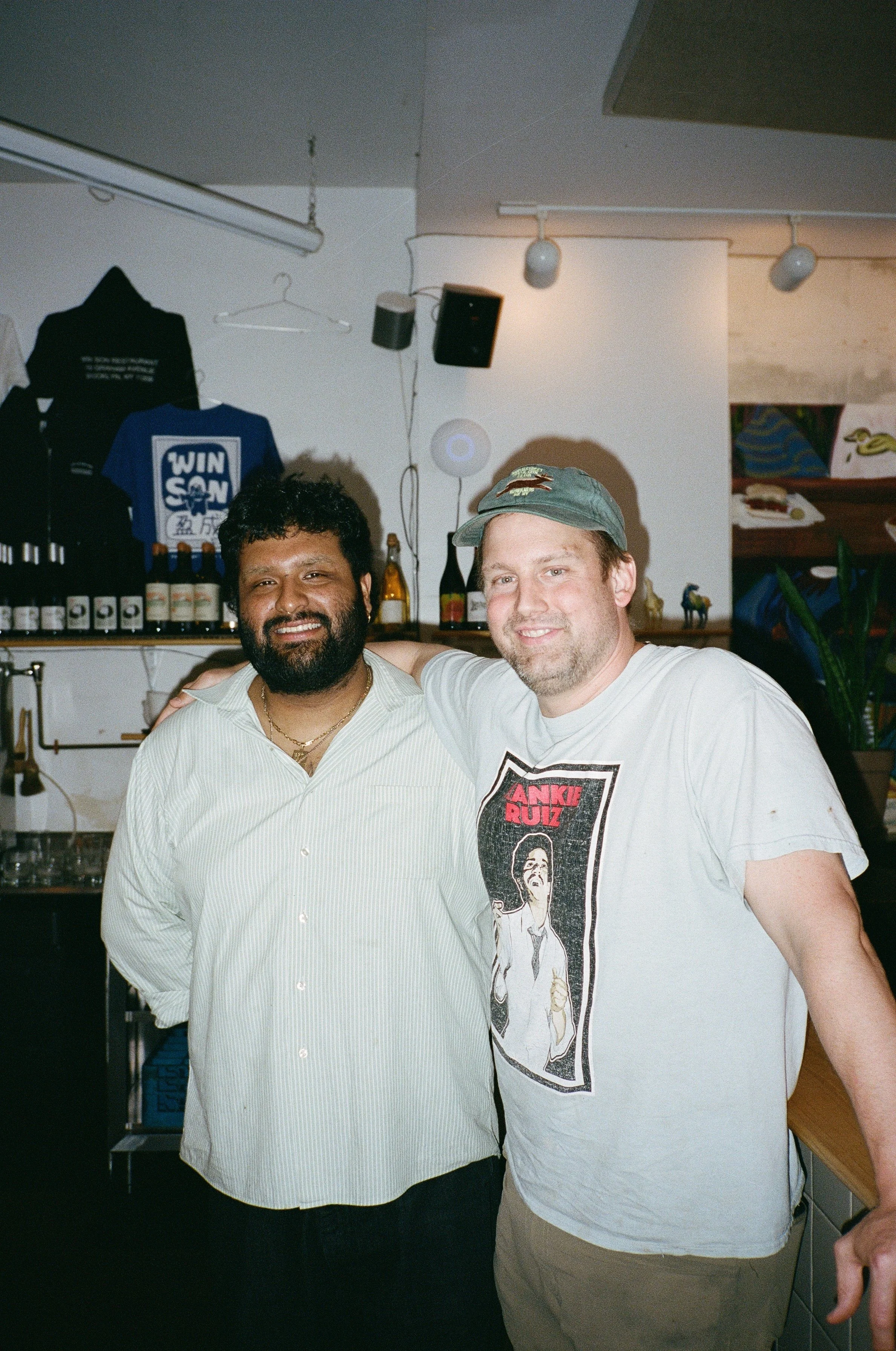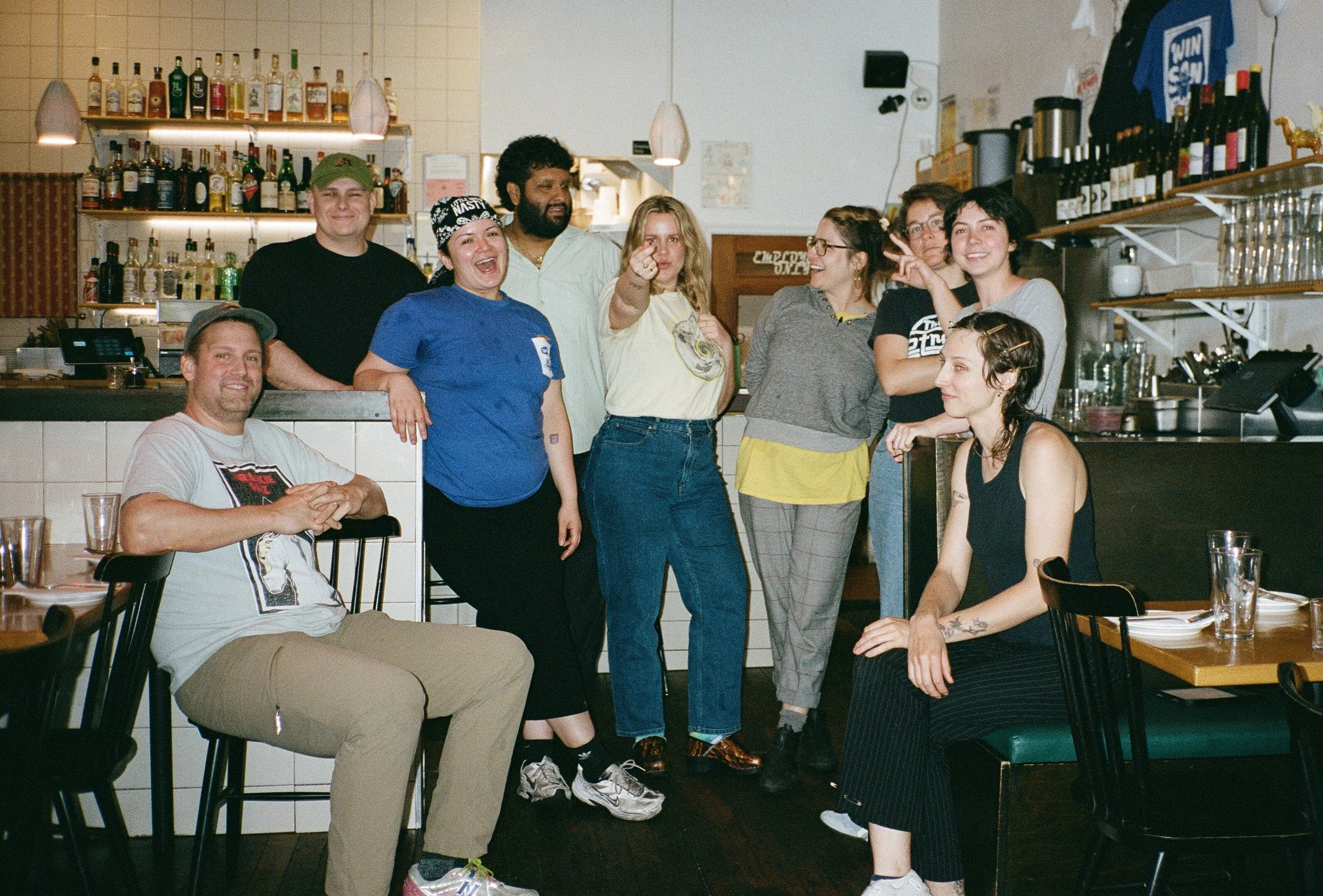How a Bakery Built One of the Most Affordable Wine Lists in NYC
Trigg Brown, chef and co-founder of Win Son, on how a casual curiosity turned into one of the city’s most personal and affordable wine programs.
Written by Megan Hopkins
From left: Megan Engler, Trigg Brown, Ángel Medina. Photo by Lindsey Molk
In New York, wine is often treated as a luxury: priced high and out of reach for many who might otherwise be interested in exploring it. But what happens when a restaurant, or a bakery, for that matter, decides to treat wine as something meant to be truly shared, accessible, and inviting?
At a time when by-the-glass pours regularly hit $18 and bottles average close to $100, the post-work, pre-dinner glass is becoming less and less affordable for most. While many restaurants and wine bars rely on alcohol sales to offset the thinner margins on food, other spots, especially those that aren’t built around wine, have more freedom to approach it differently. If the business can sustain itself on food alone, wine doesn’t need to carry the burden of profitability. And when a business like that is driven by people who care deeply about wine and the people who make it, it provides a unique opportunity for a more accessible wine list.
That’s what makes what Trigg Brown is doing at Win Son Bakery so exciting. While the scallion pancakes and mochi donuts have always drawn a loyal following (and rightfully so), it’s the evolving wine program—thoughtfully sourced, deeply personal, and surprisingly affordable—that quietly challenges how wine can exist in a bakery/café today. And while you won’t find a sommelier, or even a bartender or server to help you choose the wine from the fridge, you will find a tightly curated selection of classic producers and sought-after bottles, with prices closer to your local neighborhood bottle shop than to those at the typical wine bar.
Mochi donuts. Photo by Lindsey Molk
It’s a fitting approach for someone like Trigg, chef and co-founder of Win Son. I first met him, not in Virginia where we both grew up, or even in Brooklyn where we overlapped for years, but actually back in Richmond after I’d opened Celladora, a bottle shop and tiny restaurant. His brother Merrill was a regular, always saying how Trigg would love the place. One slow Sunday, Merrill finally brought Trigg in. I started pouring him everything we had open by the glass—no markup games, just wines we were excited about.
Trigg most certainly didn’t hesitate. As I finished up service, I kept dropping half-filled bottles on their table. He’d down them, ask a few great questions, then wait excitedly for the next. I wasn’t sure what to make of him at first—I hadn’t seen someone throw back wine like that in a while—but his curiosity, energy, and pure love for the stuff was infectious. That’s Trigg. Since then, we’ve become sounding boards for each other, trading importer tips, doing pop-ups with friends, and (after some convincing) even getting him to spit at tastings.
Fast forward, and now Trigg is slowly building one of the most interesting and accessible wine programs in New York—not just at Win Son, but across their two bakeries, including their newest location in the East Village. The wines reflect his relationships with winemakers and his desire to make them available to more people. Where else in the city can you drink a bottle of Christian Tschida’s Grand Cuvee Himmel Auf Erden for $66 or Axel Prüfer’s Avanti Popolo for $34 alongside a fried chicken milk bun?
And now, after seeing what Trigg carried over to the East Village location that opened just a few weeks ago, we wanted to dig a little deeper to get a better sense of how it all came together.
How did Win Son come to be?
Win Son came to be over plates of Flies’ Head—wok-roasted budding chive fronds with unctuous, fatty pork and fermented black beans that resemble a flies head—at a Taiwanese restaurant in Flushing, Queens. My now-business partner, Josh Ku, and I bonded over disdain for our jobs, a love of weed, riding motorcycles, and Taiwanese food. His family is from Taiwan, and my mentor Pei Chang’s family is from both Taiwan and China, so when I met Josh at a backyard BBQ, we immediately hit it off. We kept exploring Taiwanese food in this stoned, spirit guide kind of way, where he'd take me to places he ate growing up and still loved visiting. We’d talk about how perfect the food was and complain about the mundane shit in our lives.
That pattern––eating, talking, wandering––is how we spent our time over the next few years. Josh was working in property management and construction with his father. He was preparing a space to lease that he was personally invested in, but no one was willing to pay the asking rent. So we decided to pay it––with a half-baked idea that we could offer our neighborhood a concession in lieu of going out to Flushing, since most people we knew didn’t have cars to make the trip. We figured if we could make the food good enough for the neighborhood, we might survive and maybe even spread our love for Taiwanese food. Maybe people would stop confusing the island nation with Thailand.
Photographed by Lindsey Molk
Were you always planning to have wine be a part of the experience at Win Son and the bakeries?
In the beginning, we barely had enough money to open. We had to launch a Kickstarter just to finish essentials like the floors, the walk-in fridge, and the basement. Wine was just a check mark for us at that point. I kind of thought it was preposterous to know enough about wine to do anything more than have a menu with a slot for each shade [white, skin-contact, red] with something cheap and chuggable.
So when did your perspective on wine start to shift?
Under the direction of some friends, we kept the list tight and limited for about five years. During that period, though, dear friends of mine like Mike Fadem and Chris Grosso were exposing me to some very delicious wines. And I liked them so much that I started buying assorted cases for my house from Mike because everything I drank at Ops I loved and just wanted more of it. Chris and I have kids the same age, so we’d also drink really amazing wines together at family gatherings. I wasn’t really learning anything here, though. I was just enjoying exposure to the delicious food lubricants.
Was there a specific moment when it all clicked and wine became something more than just enjoyable?
That happened after I took my wife Patty to Spain. We’d somehow made it through the COVID pandemic, and having had two kids, we needed a break and tickets were very cheap. I ended up getting some recommendations from Chris and dragged Patty through Catalonia, tasting wine and eating some of the best food of our lives. At Gresca in Barcelona, the server asked us what we’d like to drink. We asked him to bring us a bottle of whatever he was excited about because we didn’t have any knowledge of Catalonian wines. He brought us a bottle from Laureano Serres at Domaine Mendall and it was game over. It was the best meal of my life, and the wine was no less extraordinary.
The next day for lunch, we drank Rosé Cava Reserva bubbles for like fifteen bucks, alongside sandwiches with Pyrenees sausage called Butifarra and cold smoked, fried pork rib with roquefort and peppers. Then we drove forty-five minutes south through the Penedès, where Cava is produced, to Tarragona and were drinking Celler Tuets at El Cup Vell before jumping in the Mediterranean on our way to Valencia. It was bonkers, and the craziest part was how affordable it all was. And it continued like that. At El Cup Vell, the kind owner drew us a map of the Ebro River Valley, pointing out stops that were just cell phone numbers of vignerons. We met winemaker Bàrbara Forés and tasted her wines with her and her mother in their seventh-generation, family-owned bodega. It was life changing. We then went south to Valencia stopping at seaside restaurant recommendations along the way that continued to blow us away with affordable food and wine of the highest quality.
How did you start acting on that shift once you were back in New York?
I was fully hooked at that point and tried to weigh in on my own list at the restaurant when I got back but it was very controlled and we were focused on COVID recovery so I sort of shied away from it. Instead, I started bringing these wines I was enjoying back home home when visiting family in Richmond. After one of those visits––cooking for my family and pouring wines I was excited about––my brother suggested I meet you and check out your shop near his home.
That experience was both enchanting and educational. Celladora is an oasis. I saw wines I recognized, and you immediately started teaching me about them––and then recommended others I’d never heard of in the same breath. It was as if I got out of the saturated NYC scene for a second and into a slower speed that woke me up a little. At Celladora, it clicked that I was really a Luddite dumbass for not learning more about the wines I was drinking with these kind and wonderful people in such a rich place like New York. I think I was intimidated by the world of wine. I like to know what I don't know and stay in my lane, but wine became too exciting and enticing to continue avoiding.
Was there a moment when you realized you were ready to take a more active role in the wine program at Win Son?
From left: Ángel Medina, Trigg Brown. Photo by Lindsey Molk
Yes, shortly after that. Chris brought me a magnum of 2017 Jean-Yves Péron Vers la Maison for my daughter's birthday. I called you the next day because I needed to figure out how to get my hands on these wines I was falling in love with, that were becoming really important because they were tied to milestone life events. You said: well, you have a restaurant, so you should put the wines on your list, get exposure for the winemakers and put the personal stuff on the back burner as a secondary priority.
I still approached it timidly as we only had about 12 wines on the list. But I proposed a strategy, guided by your advice, to support the books more emphatically—that we consolidate our purchasing into fewer [importer & distributor] books so we could explore them more thoroughly. Mike has always been an open book and a resource to me, and Chris will comb through the portfolios with me, share insights and make recommendations. You would do the same and had continued introducing me to importers and generally weigh in as well. My dear friend and right hand at Win Son, Brian Girouard––who’s a man of few words––recommended that I take a more active role in the wine program. That meant a lot. So I did.
How did that shift ripple out across both Win Son and the bakeries?
My team was extremely helpful and supportive of it, especially Scott Conrad, Isaiah Paulino, Stephanie Auquilla, Ángel Medina, and now Caleb Cronan and Megan Engler. We all learn together. As our list grew into the hundreds, we started incorporating the same strategy at the bakery, but with a more concise by-the-glass selection and a wine fridge stocked with a small by-the-bottle list of wines we love from Win Son. We sell them affordably at both places with a lower mark up and even more so at the bakery. We’ve always strived for accessibility. And as you had pointed out, since we can’t really provide full wine service at the bakery, offering retail-like pricing lets us keep the wine affordable and move bottles we believe in. Otherwise we couldn’t really justify presenting things like Ca di Noci, Le Coste, Tschida, Matassa, and François de Nicolay alongside Win Son Bakery food.
What continues to draw you to wine now?
I just want the wine to be as good and exciting as the food. And I'm a people person. I fall in love easily, namely with stories and people’s passions. Wine became a way to tap into that. I’m visual, so I like learning about wine through landscapes, people, grapes, and their context makes sense to me. Manel Aviñó, the Bubble Man at Clos Lentiscus, once told me that Xarel-lo is Catalonia’s Chardonnay and Sumoll is their Pinot Noir. I thought this was so fascinating especially considering the chalky, seaside soils of Clos Lentiscus compared to Partida Creus’ red clay soils just thirty minutes away. That trip was particularly great because I had the honor of cooking with Rich Ho, founder of Ho Foods, at the Partida Creus harvest party thanks to Chris Grosso and our friend Clovis, who took us there and invited us to cook.
I remember visiting Matassa and watching Tom Lubbe’s mad-scientist, organic chemist approach to balancing acid and sugar while pressing with the stems just right outside his bodega; in contrast, seeing Giovanni and Alberto Masini’s approach at Ca’ di Noci, where they work more by the touch with harvest and picking, but chilling their grapes before destemming and pressing. They also make less wine, so it’s super controlled. Tom’s method is definitely more scientific but the desert-like dry climate and the grapes he grows in Roussillon seem to allow him to let the grapes guide him while he sees how they act and measures their contents more. Whereas the Masini brothers are no less natural, but the climate is green and luscious in Emilia-Romagna and their parcels are right there by the farmhouse so they simply aren’t experimenting in the same way. They seem to know their grapes intimately and don’t need to combat arid conditions, so there’s less need for the kind of experimentation Tom is forced to do.
I’m rambling but I think the point is the way these guys make wine is so different. They both make some of my favorite wines so seeing the domaines and taking notes helps me learn and makes reading The Wine Bible more relatable. These are experiences I can’t separate myself from and I love the way they interact with food. And it’s an honor to pair them with our food, so I’m trying to make it work. I’m lucky to know people like I mentioned beforehand. Others like Trevor Kellogg from Discovery Wines, Billy Durney from Red Hook Tavern and Hometown Bar-B-Que, and Jules Dressner from Louis Dressner Selections, Camille Riviera, Kelli Murchison, Jahdé Marley, and Maya Peterson have also been incredibly generous with their knowledge. It’d be crazy not to express thanks to Lee Campbell as well for her work and influence. We’re both from Virginia and she’s been so wonderful to me.
It’s funny to think something like some boozy grape juice could make me take myself and my restaurant more seriously. But not in a pretentious way––in a way that does more service to the winemakers I’ve met and the hospitality work we do at Win Son.
Photo by Lindsey Molk





